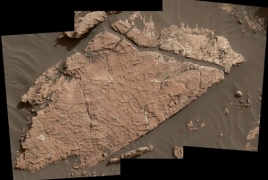Curiosity finds new water evidence in possible cracked mud on Mars January 18, 2017 - 12:04 AMT PanARMENIAN.Net - NASA's four-year-old Curiosity rover spent 2016 discovering new clues to Mars' history, including veins potentially from evaporated lakes and mineral deposits suggesting the planet once had oxygen. The craft spent the beginning of 2017 examining a newly-discovered natural formation: Rock cross-cut with ridges, which are probably mud cracks, Engadget reports. Assuming that interpretation holds up, it will be the first mud cracks (desiccation cracks) confirmed by the rover. Regardless, the cracked surface formed 3 billion years ago and was buried by layers of sediment, which all became stratified rock, according to a NASA blog post. Wind erosion exposed the split pieces, which are located in an area known as "Old Soaker" on lower Mount Sharp. Other evidence in the site includes a layering pattern called cross-bedding, which could have formed where water flowed vigorously, as in near the shore of a lake. Then again, it could have been made from windblown sediment during a dry episode, Engadget said. Yerevan will host the 2024 edition of the World Congress On Information Technology (WCIT). Rustam Badasyan said due to the lack of such regulation, the state budget is deprived of VAT revenues. Krisp’s smart noise suppression tech silences ambient sounds and isolates your voice for calls. Gurgen Khachatryan claimed that the "illegalities have been taking place in 2020." Partner news |